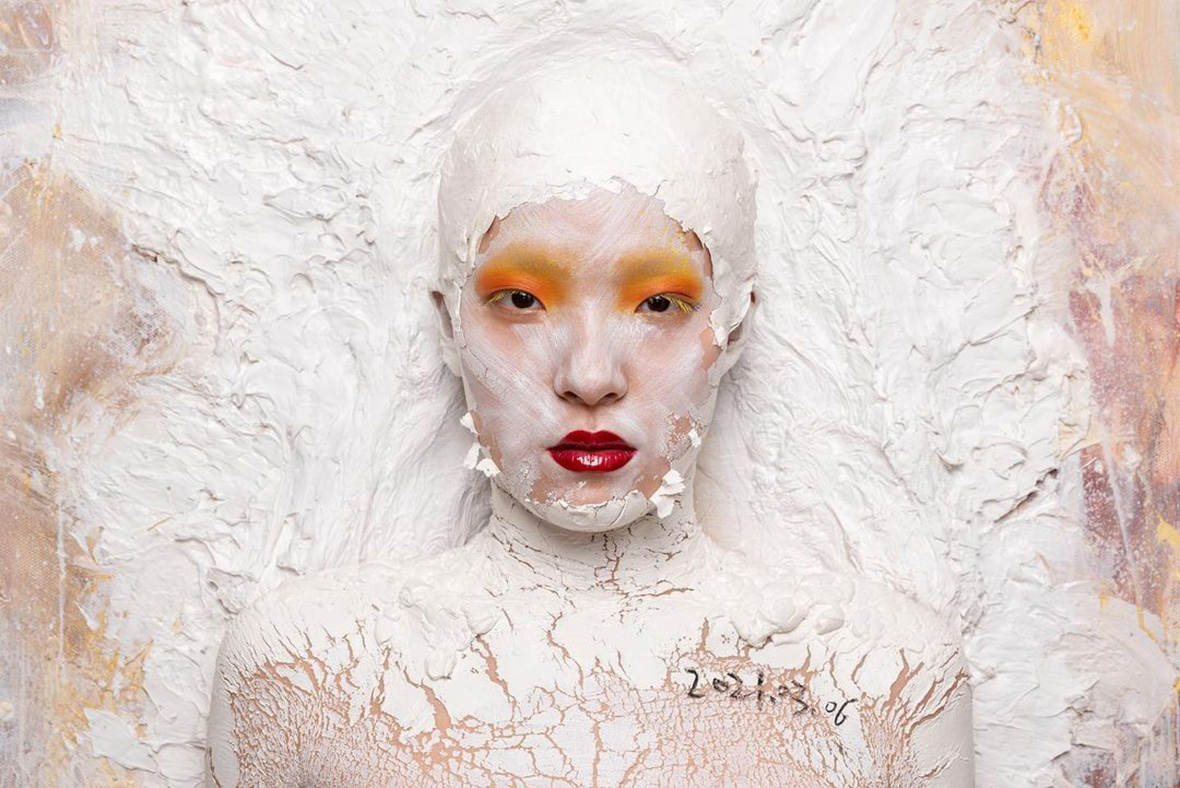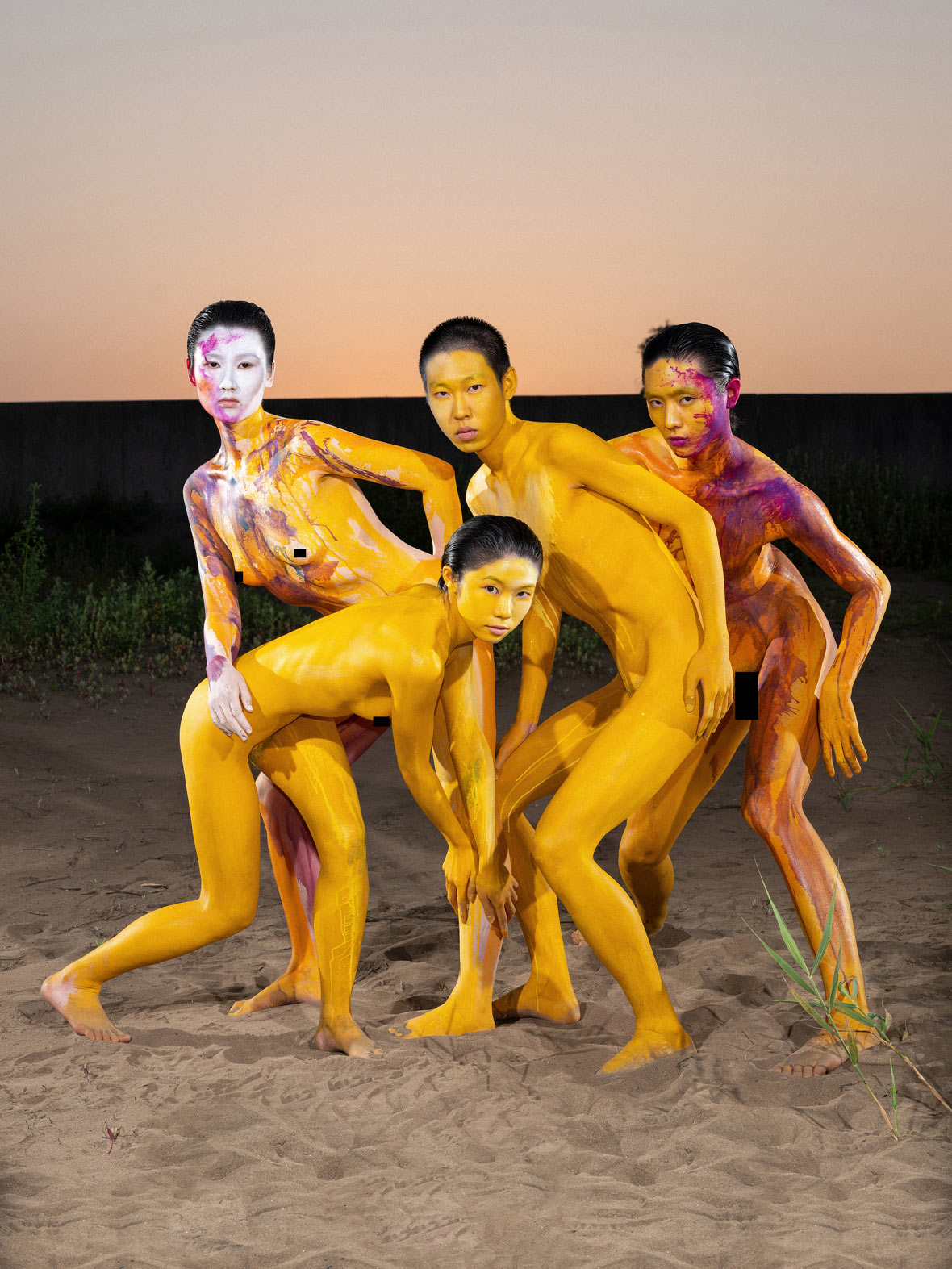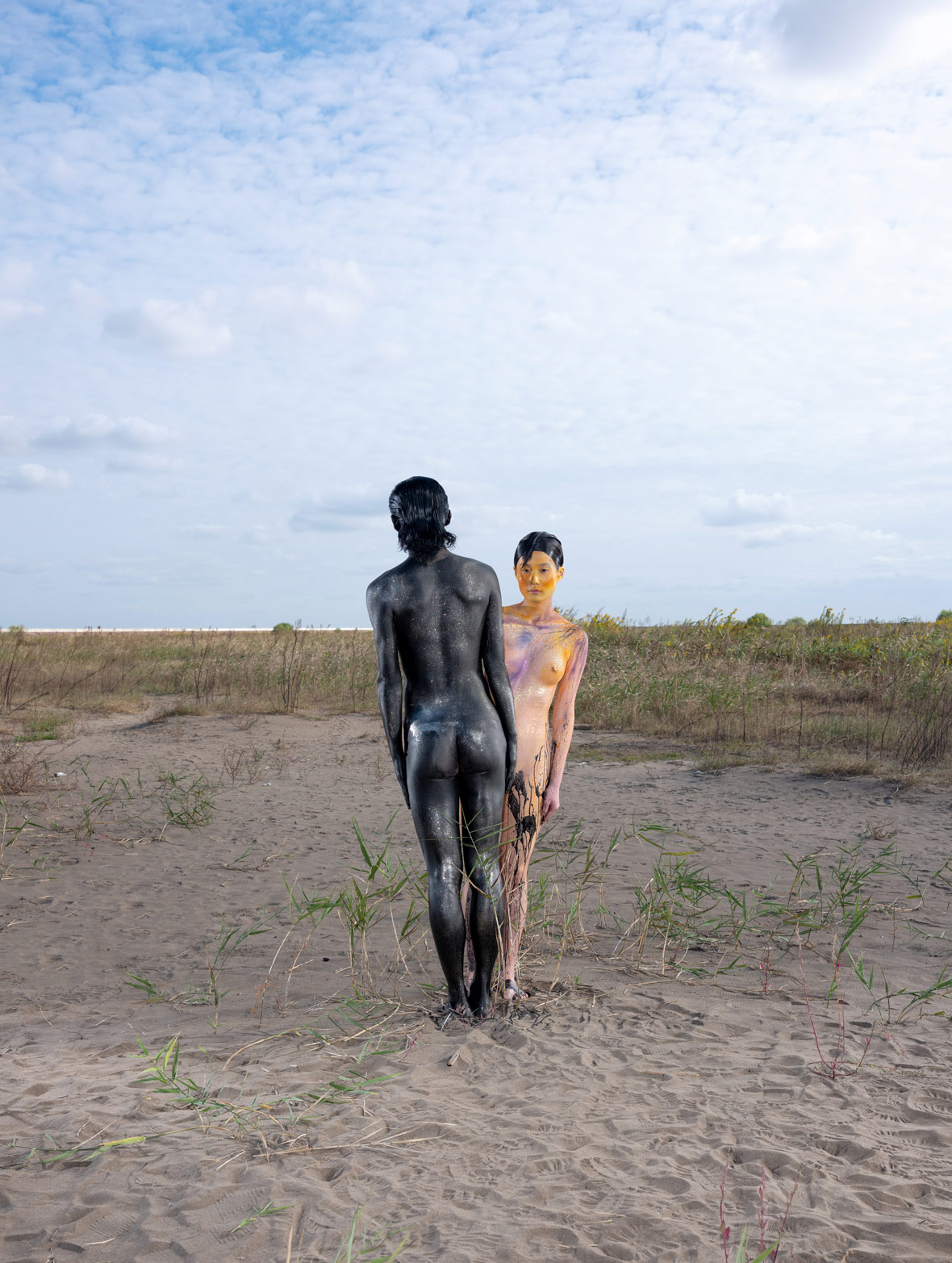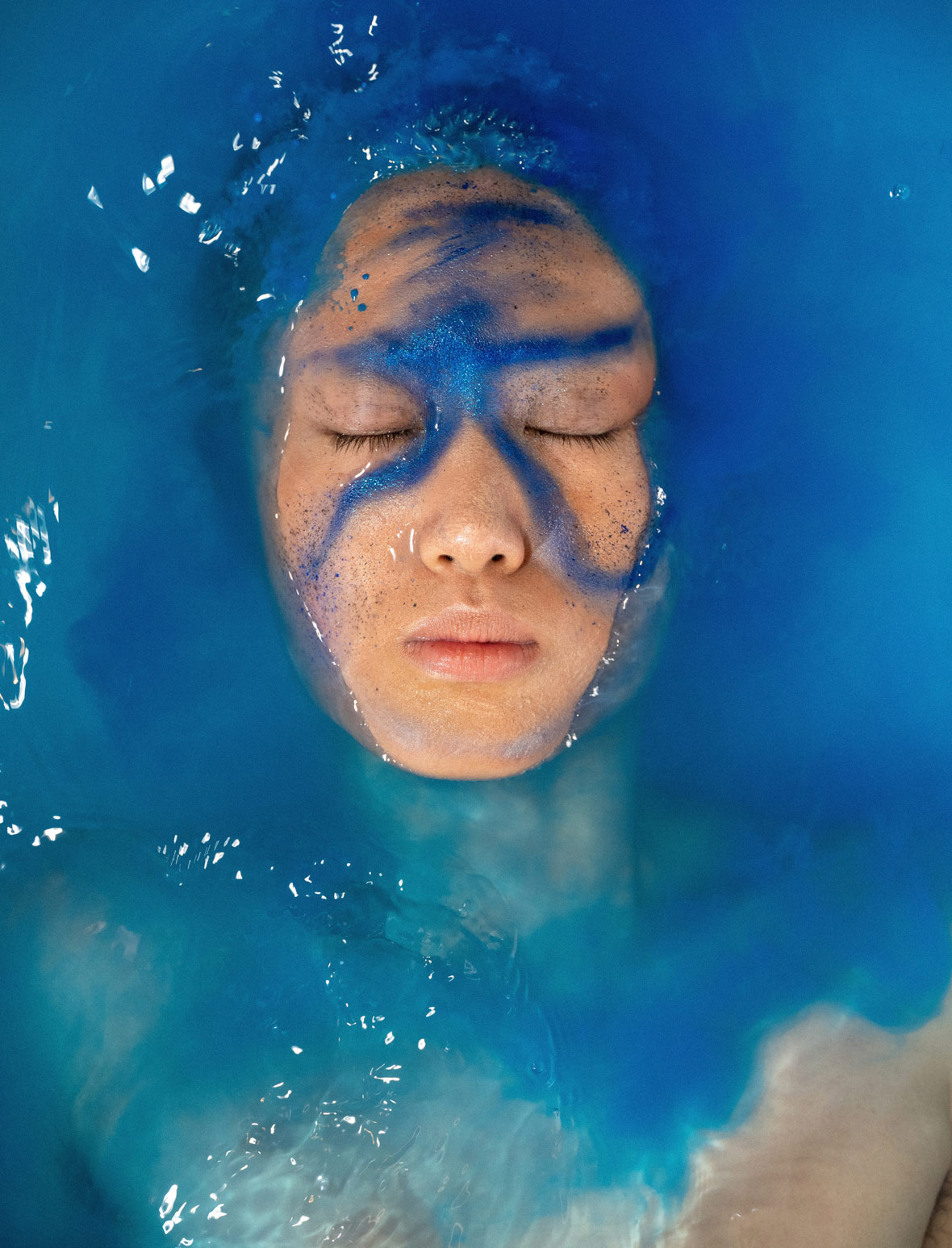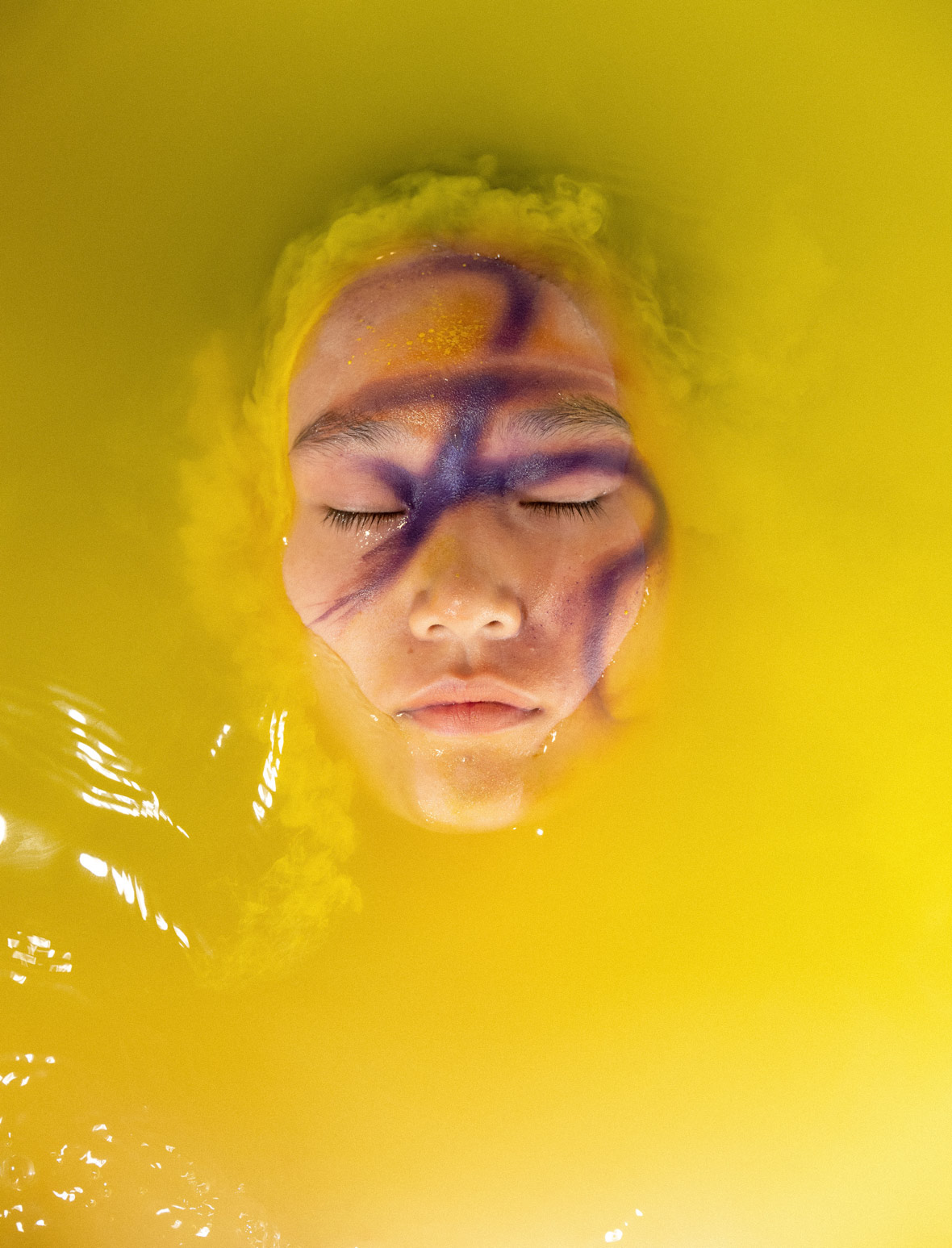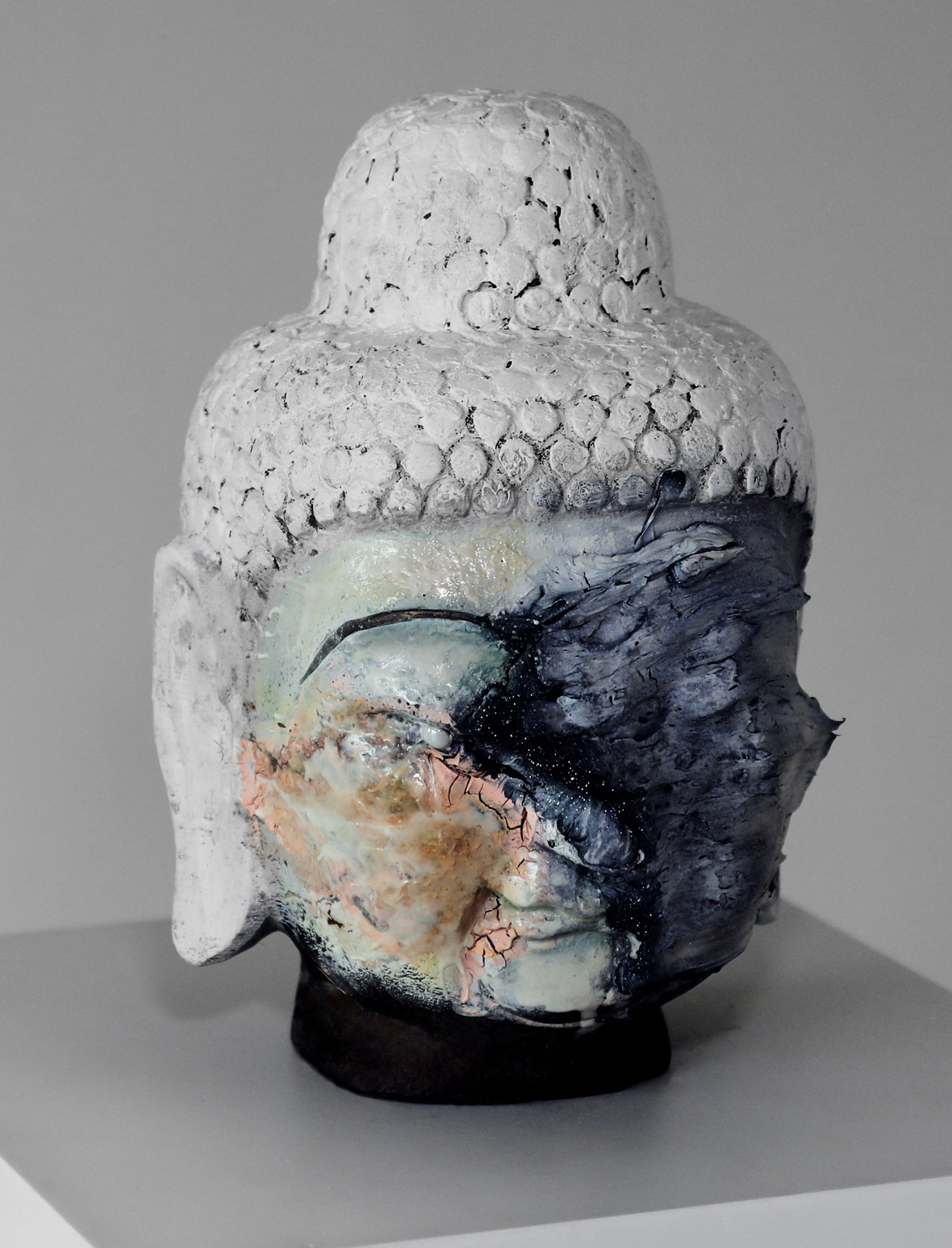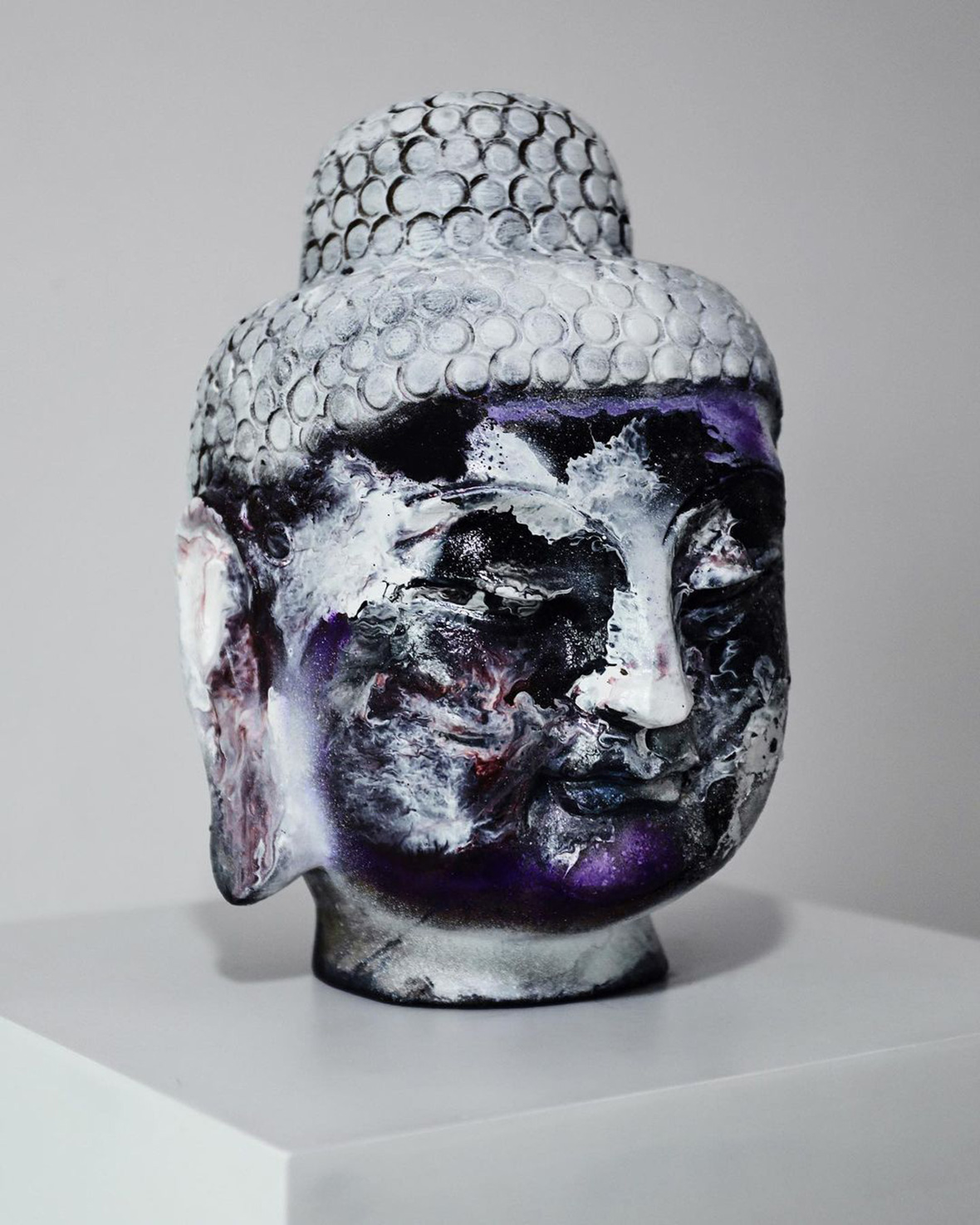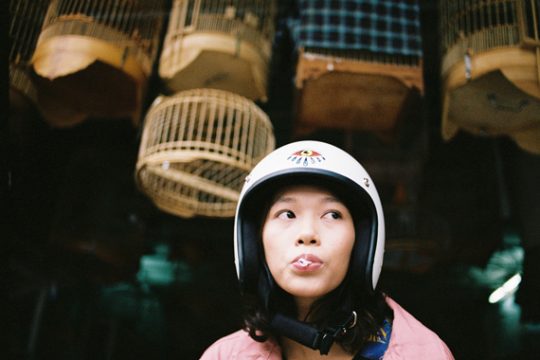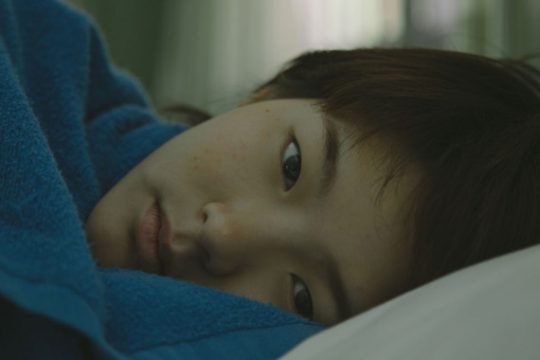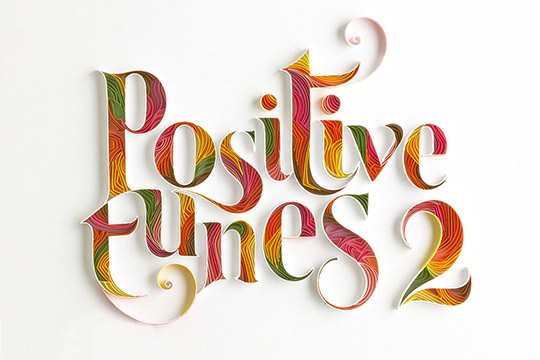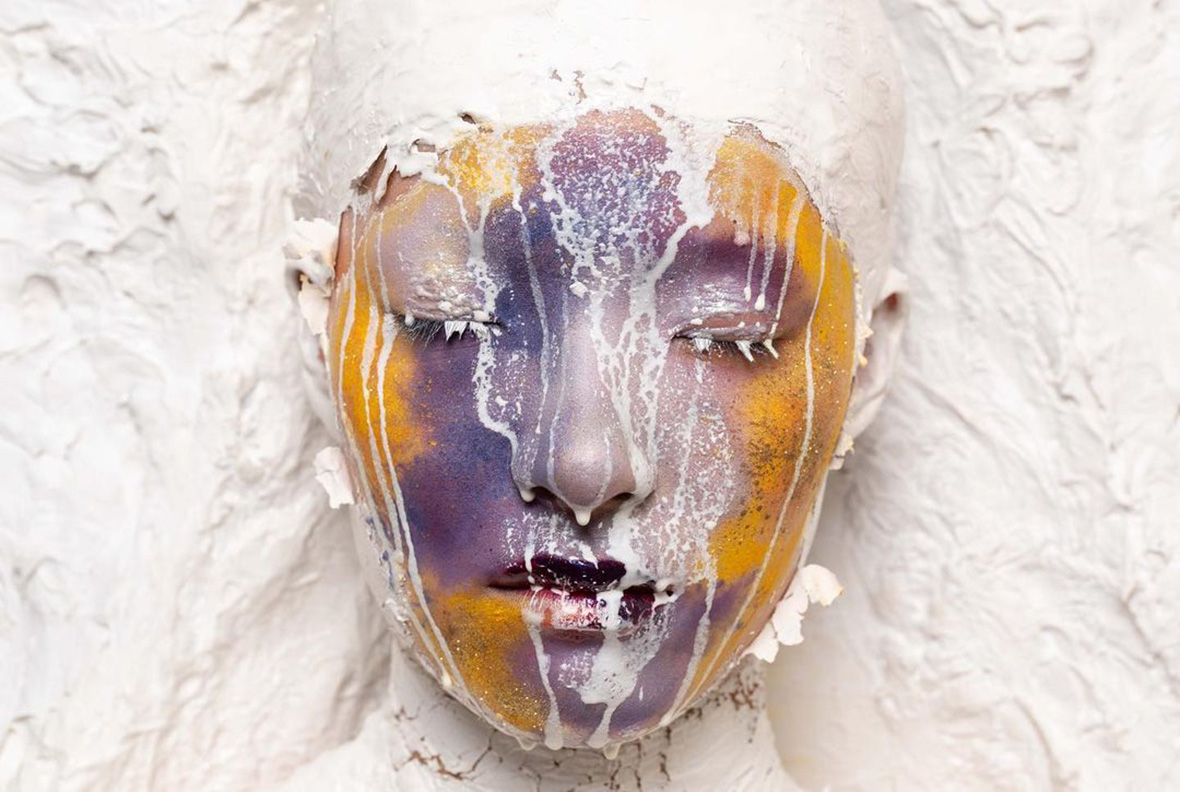
The world is a canvas, and with the right colors, you can reshape reality. To Gao Shan, colors carry a certain sensuality, and an artist’s palette choices can be incredibly revealing of their inner world. With these philosophies in mind, the Chinese artist has created a body of work populated by human faces coated in a wide spectrum of colors. “I want audiences to reflect on homogenization and heterogeneity,” he explains of the broader themes in his work. “Every individual is different, and every individual is free to construct their own world, a place in their consciousness that exists outside the pretensions of the external world.”
颜色,无疑是装扮现实的道具,它让我们栖息的世界如同画布,铺开无限胜景。对于艺术说,颜色更是不可或缺的创作媒介之一。艺术家高山(Mountaingao3)亦是钟情于此,他认为,颜色是感性的、像倾诉的嘴巴,替他表达并呼喊着内心的想法。但他的画布有些不同寻常,他喜欢为人物、甚至雕塑的面孔上色;不论是寺庙佛头还是前卫的青年肖像,这些都意想不到地成为他的“染坊”。追问这样做的原因,高山解释道:“我希望运用人物面孔上的色彩,引发观众对于个体意识的觉醒。一张张独特的面孔,跳脱出肤色的概念,象征着每个人建立的属于自己的世界,是一个个叛逆于同质化的世界。”
Gao’s idea to use the human face as a canvas isn’t all that unusual when considering his background. Six years prior, Gao worked full-time as a professional make-up artist. He never received formal training in fine art, but his creative flames burned bright. He became infatuated by the expressiveness of the human face, believing that every individual’s demeanor spoke volumes to their experiences and personalities. “For me, the colors I paint onto people aren’t ‘adding’ to their faces,” he notes. “It’s more of a way of subtracting a person’s surface-level emotions, dissecting them to reveal the inner world that they’ve kept hidden away.”
To bring his ideas to life, Gao works with photographers who operate on a similar wavelength. The result of these collaborations is nothing short of visually stunning.
喜欢为面孔上色这件事,对于高山来说并非无迹可寻。早在六年前,非艺术科班出身的高山进入化妆师领域,从此与人脸和色彩结缘。在作为化妆师的日子里,高山常常和不同面孔打交道。通常,他会通过人物外貌来揣测对方的经历和个性,渴望以此来进行更多创作上的尝试和可能。他说道:“于我来说,颜色的增添并不是‘加法’,而是‘减法’,试图减去原来面孔的更多感受。 在创作的时候,有点像在解剖一张面孔,试图把其内里展露于外。可能也是试图把那个看不见的世界尽力展现出来。 ” 为了将想法记录下来,高山与不同摄影师联合创作,呈现着令人惊叹的视觉效果。

Working at the intersection of make-up art and fine art has made Gao an ideal name for a variety of brand collaborations, but his own projects are where his heart is. Nihilistic, an ongoing series he conceived in 2020, was—as the title suggests—inspired by nihilism, in particular the idea of shedding the shackles imposed by the world and embracing one’s truest self. In a recent extension of the project, he visualizes individual consciousness by smothering his models’ faces in colorful make-up, which is then covered by another layer of paint. These models are then submerged in tubs of water and photographed as their face emerges from the water’s surface. As the outermost layer of paint dissolves, a new layer of color beneath is revealed. With their eyes closed, they seem comfortable with their true colors being shown—unconcerned with the external world.
现在,除了时尚相关的化妆项目以外,高山已陆续推出两部个人系列作品。《虚无》是高山于 2020 年开始创作的系列。之所以称之为“虚无”,是高山在创作之初深受哲学家尼采所提出的“虚无主义”启发,其认为每个人都应该放下现实的束缚,投入到真正享受自我的世界。而这一点在他的作品中体现得尤为突出,照片中,每组人物面孔的颜色都不尽相同,他们脱离了本来的肤色,彼此互不争辩。似乎也不想与外界保持同一种颜色,只愿沉浸在属于自己的颜色当中,独自叙事,尽显虚无对于现实的声讨。

In the latter half of 2020, Gao’s manipulation of color extended beyond faces alone, and he began coloring in human bodies in their entirety. In one series, six models appear in two different colorways: three were painted entirely in black, while the other three appeared in lighter colors that were being consumed by similar blacks that cover the lower half of their body. This project was inspired by French psychologist Gustave Le Bon’s book The Crowd: A Study of the Popular Mind, which describes individuals as being rational, and crowds as being irrational. Once individuals gather and form a crowd, the crowd can become senseless, becoming something completely different from the individuals.
The stark contrast between the obsidian-covered models and the models not yet consumed by the black paint visualizes this transformation. The black paint is intended as a metaphor for a Chinese idiom stating that an individual’s behavior is influenced by those they’re surrounded by. “In this series, the colors represent individuality,” he says. “It’s a symbol for the pursuit of diversity. The work as a whole is meant to show the tug-of-war between individuals and a collective.”
高山于 2020 年中下旬创作的一组关于“虚无”的作品中,色彩的尝试蔓延至人体全身。六位模特,一半被深黑色笼罩、另一半则鲜艳生动。创作之初,他正在研读法国社会心理学家古斯塔夫·勒庞(Gustave Le Bon)的著作《乌合之众》,书中提到:“群体具有非理性特征,个体可能具有理性特征,一旦当个体聚为群体之时,其身上的个人特质会被抹除,变得歇斯底里。 ”因而,高山在作品中引用了大量黑色与彩色的对比,来隐喻群体中被抹去个性的人,沉浸于无尽的黑夜;以及跳脱出群体的鲜艳个性,在黑暗的世界里闪耀夺目。他解释道:“‘黑’在这里是一种近朱者赤,近墨者黑的比喻,‘彩’则在创作中表达为个体间的一种丰富多彩,其追求细节多样性的比喻。也有点像一场个体与群体之间的意志斗争吧。”
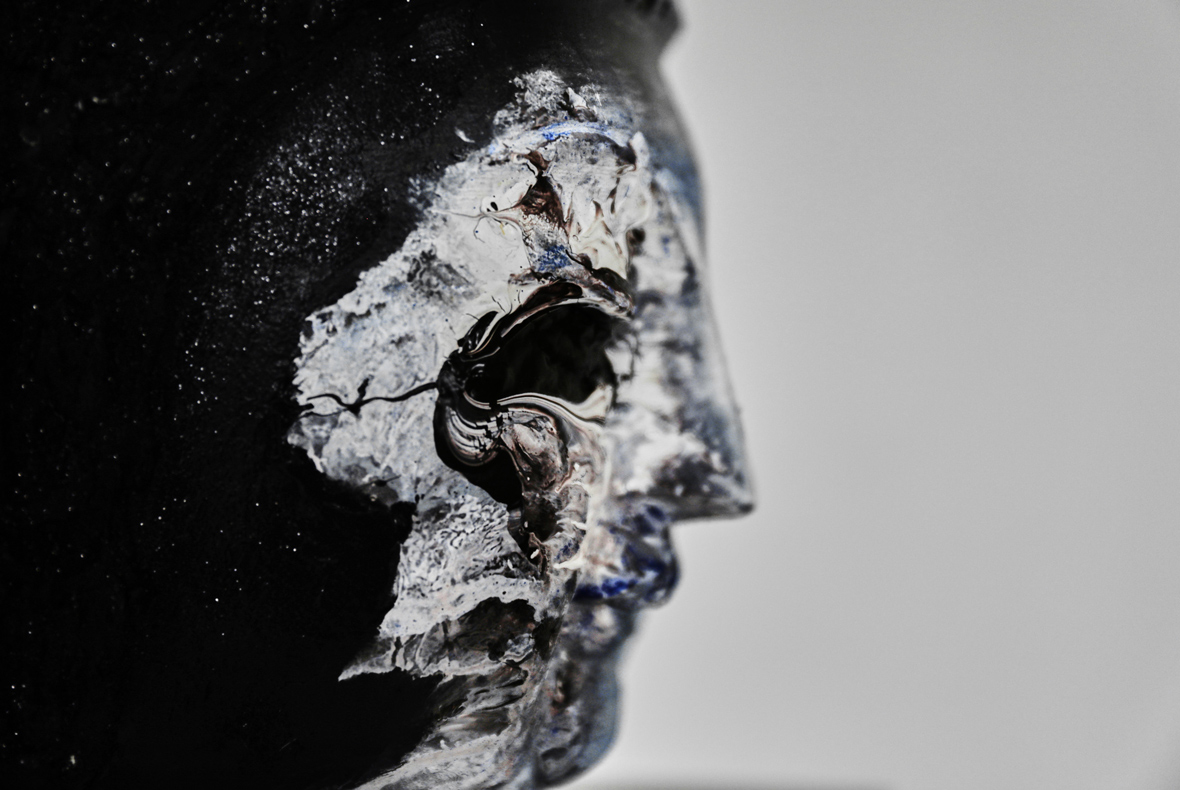
Gao is a literature lover, and it’s through his literary explorations where he discovered the Diamond Sutra. A profound quote from the famous scripture states, “Everything with form is unreal.” This concept of an illusory reality and the realization that there’s wisdom to be gained in accepting the illusion inspired him deeply. It led to the idea for Buddha Project, a series of sculptures where Buddha heads were covered in splashed ink. Through these splatters of color, Gao offers forth his meditation on illusions and truths while imubing these traditional forms with a contemporary vitality.
高山承认自己是个爱书之人,在他的另一系列作品《Buddha Project — 即兴判断》,采用佛头作为载体进行创作,颜色则以水墨的形式进行勾兑,论其灵感,是来自他读过的一部佛教经典著作《金刚经》。他对书中的一句话深受启发:“凡有所相,皆是虚妄”。其大意为,凡是世间所有的一切,都要将它当成是虚妄的,只要不去执着于它,就会产生智慧。高山将这句话的含义运用在佛祖石像本身,现实存在的佛陀雕像被水墨所打破,从实至虚;赋予了石像一层新的活力。这恰恰是书中所讲的一次尝试与实践。
There’s an undeniable poeticism to Gao’s works. He approaches his art with nuanced concepts that may require multiple re-visits to fully grasp. Meanwhile, the ambiguity of his abstract colors leaves plenty to the imagination. In a way, his art is as much about the viewer as it is about the artist. Through the faces that he paints on, perhaps we can all see a glimpse of ourselves.
高山的作品洋洋洒洒,如同多部诗歌。粗看他的作品,的确难以体会他的用意。他的作品也颇具抽象的色彩,大多是只可意会不可言传,留给观众一定的遐想空间,与东方的留白之意相契。他承认在创作时,很多时候是先去搭建视觉语言,再去构想主题。高山说道:“这样的作品更有诗兴。”而在面孔上作画,这本身就是一件极富有诗意的事情。这诗由颜料在面孔上编写,写得是一个个鲜艳的自我。
Like our stories? Follow us on Facebook and Instagram.
Instagram: @MountainGao3
Weibo: ~/ MountainGao3
Contributor: Pete Zhang


